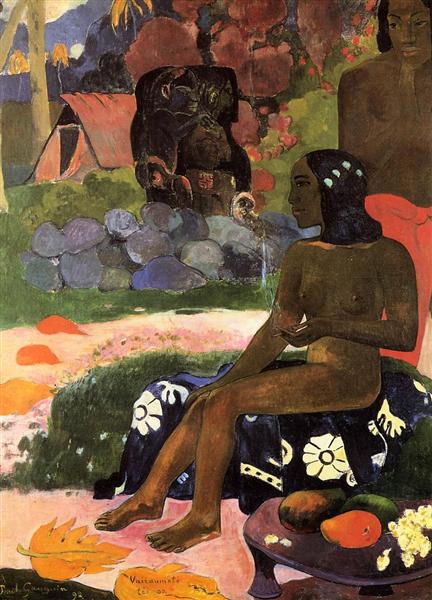Beskrivelse
Paul Gauguin's "Her Name Is Vairaumati" (1892) is a work that encapsulates the artist's relentless quest to capture the essence of Polynesian culture at a crucial moment in his career. Created during his first stay in Tahiti, this painting is essential to understanding not only his evolution as a painter, but also his assemblage of influences and his distinctive technique.
In this work, Gauguin paints a female figure who is presented as a deity or mythical figure, with the title in Tahitian lending it an air of mystery and reverence. The composition is deep and evocative, with the woman placed at the centre of the work, radiating a force of warmth and seduction. Her face and posture suggest a symbolic connection with the surroundings, which in turn seems to be a manifestation of the spirituality of the culture that Gauguin longed to understand and represent.
The use of color is one of the most fascinating aspects of “Her Name Is Vairaumati.” The vibrant hues of yellows, oranges, and greens not only capture the tropical atmosphere of Tahiti, but also evoke a sense of emotional expansiveness. The loose brushwork and defined contours create a sense of movement, as if the figure is alive and in a constant dialogue with the nature around it. This emotional use of color is a hallmark of Gauguin’s style, which moved away from Impressionism to develop a more symbolic and personal palette.
The figure at the centre of the composition displays a number of elements that reinforce her ancestral character. Her dress and the adornments that accompany her are examples of Polynesian art and dress. This choice of aesthetics is not merely decorative; it is a deliberate attempt by Gauguin to pay homage to the local culture, while seeking the universality of the human experience. This is manifest in the woman's enigmatic gaze, which seems to observe the viewer with a depth that invites reflection on identity, culture and the divine.
The work fits into a broader context of Gauguin's output, which is characterized by an interest in primitivist themes and the exploration of spirituality. Often at odds with the Western world, his works from this period are a vehicle for his own frustrations and yearnings. It is important to note that Gauguin did not aim to be a mere observer; he sought to become an interpreter of the culture around him, even as he often projected his own vision of the world and its cultural complications.
Thus, “Her Name Is Vairaumati” is not just a portrait of a time and place, but a statement of artistic intent. The painting seeks to reflect not only the contemplative woman, but also the spirit of a time and space in which Gauguin encountered resistance to modernity. It is this dialogue between figure and environment, between the contemporary and the ancestral, that gives the work its enduring value and its ability to continue to inspire diverse audiences. Ultimately, this work joins the rich tapestry of modern art, where the search for essence blends with personal expression, creating a legacy that endures through time.
KUADROS ©, a famous painting on your wall.
Hand-made oil painting reproductions, with the quality of professional artists and the distinctive seal of KUADROS ©.
Painting reproduction service with satisfaction guarantee. If you are not completely satisfied with the replica of your painting, we will refund 100% of your money.

